Hello Tolkien fans, Jackson fans, salty purists, and everyone in between! Welcome to part II of this analysis of The Hobbit Trilogy: three films produced by Warner Bros and directed by Peter Jackson. Three films inspired by a lovely little folktale written by an English professor and war veteran. But more importantly, three films inspired by three different films which the director had already made more than a decade ago.
Okay I’m starting off a little dry, but if you couldn’t tell from part one of this dissection, I take issue with some of the decisions made by the creative team behind this bloated CGI slogfest.
A Legacy To Uphold
Over the summer I read Beren & Luthien (it’s beautiful), and in the introduction, Christopher Tolkien states plainly that it would most likely be the last of his father’s tales that he would finish. But damn if he didn’t step his game up because they have announced The Fall of Gondolin to be released in August of 2018! I agree with the sentiment that this is the Holy Grail of Tolkien texts, as I nearly fell to my knees in praise upon hearing the news for the first time. This will complete all three stand-alone novels for what Christopher considered to be the three main stories of his father’s Silmarillion (Children of Hurin, Beren and Luthien, Fall of Gondolin) and really flesh out the literary legacy.
It would also make sense to why Christopher (being in his 90’s) has chosen to step down as literary executor. He’s finally done. He’s pieced these narratives together to the best of his abilities and now, like Frodo passing the last pages onto Samwise, he’s putting his father’s stories into the hands of—oh, I’m getting emotional—some hopefully trusted estate members, and most importantly, onto us; the fandom.
This brings us back to the purpose of these articles in the first place: Amazon is working on what they are calling a “Lord of the Rings Prequel Series”, and frankly, it has me worried.

There is just so much at stake here for fans of JRR Tolkien’s works and the depictions of his legendarium. While it’s important to bring in new audiences, it’s far more important to keep the integrity of the stories you were “inspired” to recreate in the first place intact, isn’t it? You know, things like the themes, plot structures, character, and story arcs? Or are we more interested in consumable spectacle and dollar signs? As far as analyzing the The Hobbit trilogy is concerned, I feel that’s the impasse we’ve reached.
There is so much of this story still to tell, and so much more they’ve added to the narrative that we are now committed to. By the end of An Unexpected Journey, we’ve been swept out of our armchairs and called to adventure, and after much delay, they’ve (Jackson and Co.) managed to squeeze out a narrative about longing for home, about choosing compassion over violence if the choice presents itself, and about finding your place among a company while being true to who you are. And that’s me being super generous.
So that’s where we’ve left off. Let’s see where the next installment brings us…
Unpacking The Prologue
Remember the prologue of the first film where the Hobbit narrative begins through a meta-lens of the main character in a different time period, played by an actor that never again appears in the film? Well they drop that concept completely for their second installment. It actually serves this installment rather well, but at the same time makes the opening sequence of the previous installment that much more superfluous and infuriating.
That all being said though, the opening scene of Desolation of Smaug (DoS) is actually one of my favorite scenes in the Hobbit Trilogy. It draws us back into the narrative with purpose and intrigue. It brings us back to a familiar setting—Bree—but it doesn’t indulge in nostalgia. To be fair, yes, the nostalgia element is unavoidably there, complete with a Peter Jackson cameo of a character who seemingly ages in reverse, but Bree is simply a plausible place for a traveler like Thorin Oakenshield to take refuge on a dark and rainy night. Bree also happens to be in close proximity to the Shire explaining why Thorin is out in this region of Middle Earth in the first place (searching for his father) and ties in how Gandalf came to realize his plan of putting allies back into Erebor. Of course, Gandalf already possesses the Map and key to the mountain, but he’s not ready to reveal such precious cards in his hand just yet. He wants to entice Thorin with a plan.
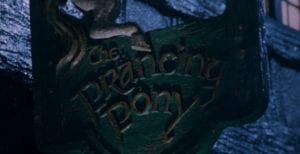
Now, in The Hobbit novel, we come to know that Gandalf received the key and map from Thrain in Dol Guldur before the story takes place, but since Gandalf will be returning to Dol Guldur later in the film, this detail doesn’t really matter until later. What’s important here is that Gandalf received items from Thorin’s father, encountered strangers on the road that were looking for Thorin, and knew he would be able to locate the dwarf in order to begin his plan. We’ll come back to this point later.
Queer (And Uneventful) Lodgings
So here we are at the Inn of the Prancing Pony on a stormy night, having a “chance meeting“ with a wizard and a dwarven outcast with a price on his head. Sounds like every awesome D&D adventure I’ve ever played, and the scene is shot with this lovely rendered, dark and ominous feel that relies on almost zero CGI, and is both informative and exciting. And best of all, this scene ties us back into the whole reason we’re telling this story in the first place: to hire a burglar and steal the Arkenstone away from a dragon! Well how about that, they’ve gotten us right back on track and put focus on Bilbo Baggins almost immediately…
We’re then thrown into a sequence where the party is being relentlessly pursued by the same pack of orcs they escaped from in AUJ. On top of that, they are chased by Beorn the skinchanger, whom Gandalf recalls lives in a nearby house and keeps watch over the region. The party runs into the house of Beorn in a fun chase sequence with some beautiful shots of the sweeping New Zealand countryside. Then we meet our host. Beorn’s hall is constructed with such care and detail, the character design is unique and seems to have a really interesting backstory… But then he disappears from the film, never to be heard from again. He has no effect on any of the characters, or the plot, and the characters have seemingly no effect on him either.
So Jackson & Co. literally introduce a character for no other reason than to get the company from one point to another and give time for Azog to leave for some reason, even though the orcs have literally been chasing the dwarves since the borders of Rivendell. Cringe.
The Desolation of Plot
You can blame this on the source material sure, because Tolkien is using this chapter as nothing more than fun world building. It’s an illustration of the wild creatures out in the world Bilbo will encounter. It’s a run-in with a creature that picks no side because nobody is on his side. One who has a deep love for and connection with nature, who keep to himself and has a certain misunderstood innocents about him, and who will totally jack you up if you mess with his lifestyle. But in order to translate this into film, it has to offer something for our characters to confront, or advance the plot in some way, or have some basic relationship with causality.
That’s why Jackson & Co elected to omit Tom Bombadil from the Lord of the Rings, right? A similar “respite” chapter that stops the plot. So why then include this segment at all? Couldn’t there have been a way to implement this scene and utilize such an interesting Tolkien character?
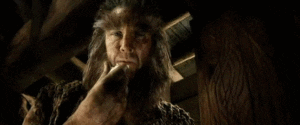
Let’s do some more musing…
- In the novel, Gandalf is leaving the company after Beorn’s House to attend the White Council, but since they already did that in the last film, they need to find something for him to do. Fine.
- I found my answer back in the prologue where Thorin tells Gandalf about the search for his father (a timeless existentialist narrative that is explored numerous times throughout Tolkien’s works) and Gandalf doesn’t give him a straight answer because he wants to protect Thorin, and protect his plans. What if Dol Guldur isn’t a recon mission, but a rescue mission?
Stay with me.
- At some point during their stay at Hotel Beorn, it is revealed to Thorin (or Fili or Kili who have nothing of note happening in their character arcs) that Gandalf was being dishonest in the prologue scene, and he actually does know the location of Thrain, Thorin’s father. He’s in Dol Guldur, and Gandalf is under the impression that he is still in possession of Thror’s Magic Ring. But Gandalf can’t risk putting Thrain’s kin in danger. He knows that if he tells Thorin the location of his father, Thorin will stage a foolish rescue mission and end up dead. So he keeps this information from him. See, now there is conflict. But how could the information about Thrain’s whereabouts leak out? If only there was a character that Gandalf would confide in and tell that he’s leaving the company to pursue a secret mission… OH I KNOW! The hobbit. Our main character.
- Gandalf lets Bilbo know that he must leave the company to pursue another matter. He is explaining to Bilbo how to get through Mirkwood. Thorin overhears a conversation between the burglar and Gandalf and demands that he be in the know. After pressing Bilbo with intimidation, Gandalf finally lets it be known that yes, Gandalf knows the location of Thorin’s father, but orchestrated this plan because he knows what’s best. Thorin MUST get to the lonely mountain before the last light of Durin’s day. This frustrates Thorin, not only because he wants to go after his father, but the fact that Gandalf kept this information from him makes him feel betrayed. This plants the seed in Thorin’s mind that Gandalf and Bilbo are conspiring, and they don’t respect Thorin as the leader of the company.
- At this point, the orcs decide to attack the House of Beorn in the night. With the company in disarray and disagreement, they must now fight for their lives. The orcs overwhelm the dwarves. They set fire to the beehives, they slaughter the animals, and Beorn decides to give the dwarves his ponies in order to flee to Mirkwood because although Beorn, like Bilbo, didn’t want all these dwarves in his dining room at first, the skinchanger now becomes an ally out of necessity. He changes into his bear form, and defends his home as the dwarves escape. They ride through the night on Beorn’s ponies until they reach the edge of Mirkwood. Gandalf is not there, but Bilbo and Thorin know why. Gandalf has gone to Dol Guldur to rescue Thrain without him. Thorin must now come to terms with not being able to go after his father. He must stay the course, not stray from the path of his destiny, just like the company must not stray from the path in Mirkwood.
It’s a metaphor, get it?
I know I know. This is not what Tolkien intended. But Jackson & Co. are about to delve so deeply into the realm of bland fan fiction under the guise of “expanding the narrative”, that the least they could do is make their story interesting. The least they could do is give their characters some inner conflict and present them with difficult choices. That’s my argument. Jackson & Co. are choosing to dramatize and expand a folk tale, and in this particular segment (Queer Lodgings) the source material is pretty much void of drama and yet they linger in this house for no reason while filling other segments with mindless action sequences that have no lasting effect on characters. So why not use it to aid your journey narrative?
You then have an opportunity to affect your main character too: imagine Bilbo desperately trying to get Beorn to abandon his home and join their company, but Beorn, a stubborn animalistic loner elects to stay with his home and fight as it burns, giving the dwarves a chance to escape. An attack from the orcs would give Beorn a purpose, and he might even scorn the dwarves for leading the orcs into his lands. Plus we’d get to see awesome Bear Beorn rip apart some orcs for destroying his adorable little home. Maybe while Thorin was arguing with Gandalf and Bilbo about not letting him in on plans, Beorn was telling the other Dwarves about how he just wants to be left alone, and that they deserved to have their home destroyed by Smaug because he views all dwarves to be greedy and selfish. And maybe you use this thing called cruel irony when the orcs come to root out the dwarves and destroy Beorn’s home, and maybe Beorn, through his own suffering, learns to pity the dwarves, and empathize, and can later (when we eventually see him again) echo Bilbo’s sentiments of “You don’t have a home, but I will help you take it back if I can”.
In the aftermath, Bilbo might even ask himself what he might do if orcs were surrounding Bag End, and he was faced with having to flee the shire or stay and fight. Why, our Hobbit might develop an emotional connection with this Beorn fellow. Our hobbit might gain some perspective about how stuffy he was when the dwarves came to visit his home, and he thought the world was ending, and the audience might just feel something, and this segment of the film might have a point!
Instead, you have this completely uneventful respite scene in a Disney vacation cottage, and some lazy fruition voice-over from from Galadriel telling Gandalf to leave.
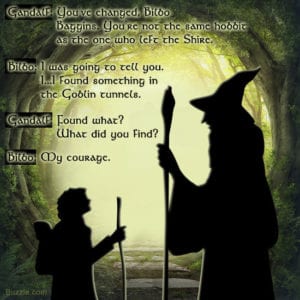
Bolg: Whom Do You Serve? More Importantly, Why Do We Care?
Okay so I don’t want it to just sound like I’m trying to legitimize my Tolkien fan fic. It’s just that this film is such an absolute mess of a narrative and somebody needs to imagine a world where three Hobbit movies were made, and they all were at least halfway watchable and cohesive stories.
Let’s take the character Bolg, for example. Azog travels to nearby Dol Guldur and becomes Sauron’s commander so he must end his hunt. It’s not explained why, but who cares. Enter Bolg, a completely different CGI baddy we aren’t given any reason to invest in or be in fear of. But Azog and Bolg are speaking Black Speech…so that’s cool I guess. Oh and it’s not mentioned in the film, but Azog is Bolg’s father. Not that the two of them ever interact again in this film, but yeah, they have a relationship that goes completely unexplored and unmentioned. We’re told mindless CGI villain number #1 Azog hates Thorin cuz reasons, and now mindless, uninteresting CGI villain #2 takes his place without motive. Great.
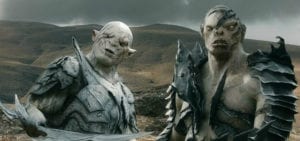
So this “evil hunting your band of heroes” concept has worked as a formula for as long as there have been epic stories to tell, right? But in order for this concept to not become such a trope the way Jackson & Co have made it, there must be clear intent, there must be some engine running the hunt.
Lurtz for instance, whom Jackson & Co. invented in order to have a monster to fear, works as an agent of evil in The Fellowship of the Ring because his character is an extension of Saruman’s unnatural dealings with nature. The Uruk-hai are the Frankenstein monster of the White Wizard. They are loyal and terrifying and resilient mutations of orcs. They also parallel Sauron’s Ringwraiths that pursue the hobbits in search of the Ring. All these enemies pursuing the fellowship: Uruk-Hai, Ringwraiths, Gollum, they are there to illustrate the corruption brought upon by the power of the One Ring. That’s the single purpose that brings this evil forth, and without it, you just have some vague, meandering concept of “bad guys”. Not to mention Lurtz and the Ringwraiths were real live actors that human brains can actually identify with.
Which brings me to another important point in why the “evil” in this film is so bland and underwhelming: keeping Azog alive cheapened the narrative from the start. Why has Azog sworn to wipe out the line of Durin? That seems like a personal vendetta that really ought to be expanded upon, but as an audience we are just supposed to understand “orcs = bad”.
I suppose you could argue that Azog wants to wipe out the line of Durin because Thorin cut his arm off, but that character trait is completely unexplored. You don’t give Azog anything but cliche, cardboard things to say or do, so let’s not pretend he’s this story’s Jaime Lannister. Jaime is a troubled and nuanced character with a redemption arc who struggles with becoming disabled and losing the very thing that made him who he was. He breaks vows in order to save lives and he hurts innocent people in order to keep secrets from those that could bring him down. Agoz on the other hand (pun intended) is a CGI plot device.
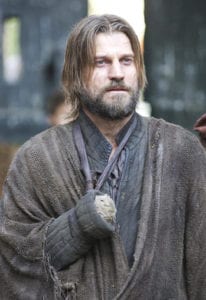
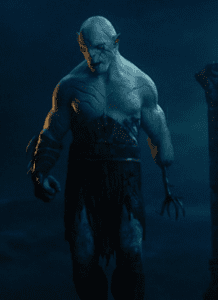
We had a more interesting character in Bolg as a Big Bad in Tolkien’s world anyway. Bolg’s father Azog was killed by Thorin’s cousin, Dain Ironfoot. You could very easily have given Thorin the kill (sorry Dain) after Azog beheads Thrór because Dain is not essential to your main plot. So the vendetta between the line of Durin and the Defiler becomes blood for blood. The death of Azog would rally the dwarves, it would give Thorin the renown necessary to unite the dwarven kingdoms in the north, and give your Big Bad Bolg a more nuanced reason for vengeance. It would also make all those over-produced cutaways of the Battle for Moria actually worth something. We’d understand why Bolg would want to obsessively hunt Thorin down and put a bounty out for him. It becomes a Shakespearean tale of family revenge that ultimately ends in everyone dying because like Shakespeare, Tolkien’s message is one that tries to show how vengeance and violence are, ummm, bad things that end in nothing but chaos, ruin, and DESOLATION. Hey, it’s like we’ve had these themes in front of us the whole time!
So instead of something interesting and threatening like Bolg being a resilient super orc seeking to avenge his father by hunting the dwarves to the ends of the earth and destroying everything in his path a la Butch Cassidy and the Sundance Kid, we get a scene completely void of drama where Azog is told by a floating ink splotch that he is to stop doing the thing he’s obsessed over for years because the plot needs him—or in the case of this stupid film, needs him at a later date.
Mirkwood
So after a whole lot of nothing happens to our company, they venture into Mirkwood, the haunted forest. Something strange happens to the perspective as soon as Gandalf exits the main quest. It becomes Bilbo’s story again. It narrows in on strange things happening to our hobbit, it shines a light on the quirky personality traits of the dwarves and presents a challenge for them to overcome. But for some reason you reeeeeally feel a tonal shift from segment to segment that’s rather jarring. Perhaps it’s because the last segment was so underutilized and offered nothing for Bilbo’s character, or perhaps it’s that getting inside Gandalf’s head is a jarring storytelling element that is a betrayal to the audience. Galadriel has acted as a pseudo-narrator in this film universe. In the original film trilogy, she enters Frodo’s head. In this trilogy, she only communicated through Mithrandir, which is direct betrayal to the text.
“Indeed we are now a good deal further east than I ever meant to come with you, for after all this is not my adventure…” —Gandalf Ch. VII
It’s subtle, and I know I’m starting to sound like a broken record, but this is just another instance of implying that Bilbo is inconsequential to what’s happening, and he’s not cool enough to have Galarial in his head, even though he’s in possession of the One Ring. In fact, it’s in this segment in particular when I first saw these films half a decade ago, where I started to get the feeling that three films might just be way too much material for this little journey. And in Mirkwood, I was filled with a sense of relief that something was finally happening to Martin Freeman for him to be able to act in.
I really enjoy this segment once they finally enter the forest though. It has plenty of fun personality and gives us a sense of peril about Mirkwood. Bilbo’s disoriented reactions with the dwarves are funny, the magic of the forest is made clear enough, and the spiders are creepy and gross, and his iconic tree climbing reconnaissance is a beautiful character moment. There is also a really interesting moment when Bilbo loses his ring, and he slaughters a larva in order to get it back. We begin to see the power of the ring take hold. I also love the fact that when he puts the ring on, the voices of the spiders are revealed, and they sound a lot like the Rankin/Bass version which is a nice touch. I do have to point out that he takes the ring off and their voices can still be heard, which is at least inconsistent, but overall it’s a great segment.
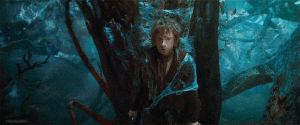
So Bilbo frees the dwarves and names his blade Sting, and they fight their way out of the spiders’ webs.
Then the party is taken captive…
“What Are You Doing In These Woods?” What Are YOU Doing In These Films?
What can I say here that hasn’t already been said a million times over? Okay here it goes: LEGOLAS IS NOT IN THE HOBBIT. Okay that’s an obvious observation. Though, he is the son of Thranduil, so it is entirely plausible for him to be here in Mirkwood I suppose, and thus appear in this movie. And back before this film came out, I might add, I actually was a staunch defender of the idea to have Legolas make an appearance because I thought it could be interesting. But the decision to give him such a meaty role in this film is an absolute travesty. He’s not just “in Mirkwood at the time”, he’s pulled into the narrative by contrived force.
So the elves arrest the dwarves and there is this strange fan service moment where Legolas finds a picture of Gimli and it just makes my eyes roll so far into the back of my head that I worry they may never come back out again. This isn’t Legolas. This is Orlando Bloom in a wig helping to market the film.
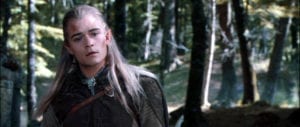
The dwarves are then taken to the elven stronghold. Lee Pace is actually pretty excellent as Thranduil in my opinion. He’s regal and beautiful and the tension between him and Thorin actually creates some decent conflict and intrigue… But this conflict is drowned out by an out-of-place budding romance/melodrama sequence that has no purpose whatsoever. That’s right. We’re bastardizing Tolkien here, so we need to fabricate an uninteresting love story with the hot dwarf whom we barely know anything about other than he’s an archer, and he’s related to Thorin, and…and he’s Poldark, isn’t he?
Nothing More Than Captain Of The Guard…
Also, Tauriel exists and there’s nothing any of us can do about it. There she is, sliding into the Tolkien universe and throwing knives and doing all kinds of other fighty things and then what do you know she’s totally single and has “likes short men” in her Middle Earth dating profile. Why? Why is she here when there are just so many reasons for her not to be?
Let’s be clear, I’m a huge Evangeline Lilly fan and understand that the Hobbit text has mention of exactly one female character in it, but that’s a rather superficial and faux reason to bring such an uninteresting side character into your already convoluted and bloated story. In short: female representation matters, but it can’t come at the cost of telling a good story with at least mildly interesting characters. Let’s look at some other female characters in the Tolkien universe you could have drawn inspiration from:
- Eowyn is a brave shield maiden who breaks through bonds of her female role of which she never had a choice in. She possesses unrequited love for Aragorn, but puts her feelings aside and rides into battle incognito in order to defend her people. She defeats the witch king in battle, an enemy they said no living man can kill.
- Arwen is Aragorn’s rock, the Luthien to his Beren who chooses to give up her most precious gift—her Evenstar, a symbol of her eternal life—in order to be with the man she loves til death do they part even if her father scorns her for it.
- Galadriel is one of the most powerful beings in the universe as far as the Third Age of Middle Earth is concerned, yet she is wise and calm enough to resist the One Ring of Power and send the Ring Bearer away with compassion for the loss of his friend, and sage advice when it was needed most.
Tauriel however, is an Elf-Ninja who kills lots of orcs and goes after a boy she likes while a boy who likes her follows in tow.
The crux of her character is that she is given nothing important to do or to want. It just seems like she’s entered this film and now her entire existence revolves around these random prisoners. I just have so many damn questions and it’s probably my fault for expecting too much out of a near three hour movie to actually flesh out some character and culture when we are brought to different places. And apparently “lowly Silvan elves” can just roam around in the dungeon and converse with prisoners at all hours. Isn’t there a festival of starlight happening? Isn’t there some traditional maiden garbs she might like to don on a night festive she apparently loves so dearly? What is the social hierarchy of this city or is it just a military base? And if it is, then where are all the guards?
And what of this love triangle Tauriel finds herself in? A trope that exists in a plethora of media today and is hardly ever done well, but can be effective if told with a purpose. Well to start, Tauriel and Legolas’s relationship is both unexplored and uninteresting. On top of that, hers and Kili’s romance is among the most tepid onscreen romances I’ve ever seen, possibly second only to Daenerys and Jon Snow’s snore-inducing love story in HBO’s Game of Thrones.
I mean what are the stakes here? Why do we need this? The dwarves are in jail. Tauriel thinks one of them is cute. Legolas thinks she is cute. Thranduil won’t allow Legolas to be with an Elf of such low standing. Tauriel agrees. She then goes after the dwarves because she had a conversation with one of them and it sounds like he might be hurt. Wow.
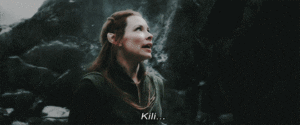
I know that Evangeline signed onto the Hobbit and explicitly did not want to do this love triangle business (and who could blame her with the way it came out?). But what if the love triangle was actually interesting and actually had consequences to the plot?
Let’s muse again and pretend there’s an actual interesting purpose for these characters to be in this film.
- Why not have Legolas pledge himself to this lowly Silvan elf despite his father? Why not have these two absolutely gorgeous elven heroes portray a couple in love and planning some secret wedding a la Braveheart? And when Fili shows up it fills her with a curious longing for something that she never thought she could feel, and it fills her with conflict because he’s a dwarf, and her people hate dwarves, and she loves Legolas but cannot help what she feels for Fili, and Fili feels it too, but she’s obviously spoken for because he sees the way her and Legolas act around one another, but Tauriel also sees the way the dwarves are being mistreated in captivity by Thranduil and she’s not okay with that. And so she might possibly even have a hand in helping Bilbo set the dwarves free, and this upsets Thranduil and he banishes her, and so Legolas goes after her revealing his love for her and abandoning his father.
- Or Why not have an inverse story of Beren and Luthien, wherein Tauriel decides to take back Thranduil’s precious gems from the lonely mountain in order to prove herself worthy to marry Thranduil’s son? This would give her an actual purpose and smash some elven gender norms and tie in a direct Tolkien narrative about devotion and the struggle of love in the face of marriage politics.
All I’m saying, been saying, is if you’re going to murder one of my favorite childhood characters in Legolas, and betray my favorite childhood novel, you’ve got to at least raise the stakes and make this plot about something, make it stand for something, otherwise this entire love triangle thread is a waste of everyone’s time because none of the characters are given any type of struggle, or risk, or lesson, or narrative payoff.
It’s. Just. Filler. It’s vapid pop culture garbage in its worst form: content that is both safe and yet still manages to insult the original text. Tauriel and Kili flirt with some of the most grating and dull dialogue I’ve ever seen on screen. Legolas looks on like a total creep and is reduced to an unlikable wooden orc-hunter in this film. And that’s just the BEGINNING of their screen time.
Of course, none of this plot musing about Legolas & Tauriel amounts to a hill of beans compared to the actual solution that would fix this film: Don’t invent up characters you think the audience wants to see and invent some go-nowhere-do-nothing plot because none of this has anything to do with the Hobbit. But if we HAVE to have Orlando Bloom in the film, give him a cameo or a scene with Thranduil or something and then allow the actual characters in the actual source material to shine. Dragging a beloved film & literary character into a narrative in which he doesn’t belong just to add filler is one of the worst sins imaginable you can do to a fandom. Sure, he was technically alive during that time period, but so was Aragorn, and Iluvatar help you, Jackson& Co. if you wrote that character into the script.
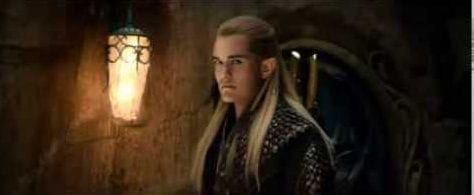
So it’s not just for the fact that Legolas was never in the Hobbit novel, or that Tauriel doesn’t exist in any Tolkien text at all ever, or that she’s a total Mary Sue, or the fact that Jackson & Co assume females can’t enjoy Tolkien without there being a certain percentage of female representation reached, or for the fact that Tauriel is invented purely as a contrived romantic interest and plot device that the actress herself was not happy about…I mean yes, it is all these things, but the main issue is as follows: Tauriel & Legolas mean absolutely nothing to Bilbo Baggins and never exchange a single word with him. This is terrible, terrible storytelling.
So the dwarves finally escape Mirkwood, but I forget how. Oh yeah, there’s a hobbit with a magic ring somewhere or something. Bilbo frees the dwarves and they sneak unseen into the cellars. Bilbo rushes them into barrels and sends this narrative into something I didn’t think possible… An action sequence more cartoonish and nonsensical than the escape through Moria.
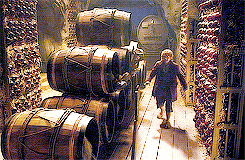
To be continued in part III…

